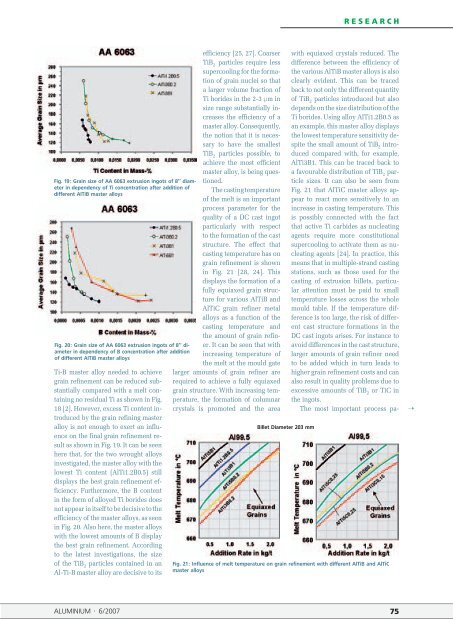Erfolgreiche ePaper selbst erstellen
Machen Sie aus Ihren PDF Publikationen ein blätterbares Flipbook mit unserer einzigartigen Google optimierten e-Paper Software.
Fig. 19: Grain size of AA 6063 extrusion ingots of 8‘‘ diameter<br />
in <strong>de</strong>pen<strong>de</strong>ncy of Ti concentration after addition of<br />
different AlTiB master alloys<br />
Fig. 20: Grain size of AA 6063 extrusion ingots of 8‘‘ diameter<br />
in <strong>de</strong>pen<strong>de</strong>ncy of B concentration after addition<br />
of different AlTiB master alloys<br />
Ti-B master alloy nee<strong>de</strong>d to achieve<br />
grain refinement can be reduced substantially<br />
compared with a melt containing<br />
no residual Ti as shown in Fig.<br />
18 [2]. However, excess Ti content introduced<br />
by the grain refining master<br />
alloy is not enough to exert an influence<br />
on the final grain refinement result<br />
as shown in Fig. 19. It can be seen<br />
here that, for the two wrought alloys<br />
investigated, the master alloy with the<br />
lowest Ti content (AlTi1.2B0.5) still<br />
displays the best grain refinement efficiency.<br />
Furthermore, the B content<br />
in the form of alloyed Ti bori<strong>de</strong>s does<br />
not appear in itself to be <strong>de</strong>cisive to the<br />
efficiency of the master alloys, as seen<br />
in Fig. 20. Also here, the master alloys<br />
with the lowest amounts of B display<br />
the best grain refinement. According<br />
to the latest investigations, the size<br />
of the TiB 2 particles contained in an<br />
Al-Ti-B master alloy are <strong>de</strong>cisive to its<br />
ALUMINIUM · 6/2007<br />
efficiency [25, 27]. Coarser<br />
TiB 2 particles require less<br />
supercooling for the formation<br />
of grain nuclei so that<br />
a larger volume fraction of<br />
Ti bori<strong>de</strong>s in the 2-3 μm in<br />
size range substantially increases<br />
the efficiency of a<br />
master alloy. Consequently,<br />
the notion that it is necessary<br />
to have the smallest<br />
TiB 2 particles possible, to<br />
achieve the most efficient<br />
master alloy, is being questioned.<br />
The casting temperature<br />
of the melt is an important<br />
process parameter for the<br />
quality of a DC cast ingot<br />
particularly with respect<br />
to the formation of the cast<br />
structure. The effect that<br />
casting temperature has on<br />
grain refinement is shown<br />
in Fig. 21 [28, 24]. This<br />
displays the formation of a<br />
fully equiaxed grain structure<br />
for various AlTiB and<br />
AlTiC grain refiner metal<br />
alloys as a function of the<br />
casting temperature and<br />
the amount of grain refiner.<br />
It can be seen that with<br />
increasing temperature of<br />
the melt at the mould gate<br />
larger amounts of grain refiner are<br />
required to achieve a fully equiaxed<br />
grain structure. With increasing temperature,<br />
the formation of columnar<br />
crystals is promoted and the area<br />
Billet Diameter 203 mm<br />
RESEARCH<br />
with equiaxed crystals reduced. The<br />
difference between the efficiency of<br />
the various AlTiB master alloys is also<br />
clearly evi<strong>de</strong>nt. This can be traced<br />
back to not only the different quantity<br />
of TiB 2 particles introduced but also<br />
<strong>de</strong>pends on the size distribution of the<br />
Ti bori<strong>de</strong>s. Using alloy AlTi1.2B0.5 as<br />
an example, this master alloy displays<br />
the lowest temperature sensitivity <strong>de</strong>spite<br />
the small amount of TiB 2 introduced<br />
compared with, for example,<br />
AlTi3B1. This can be traced back to<br />
a favourable distribution of TiB 2 particle<br />
sizes. It can also be seen from<br />
Fig. 21 that AlTiC master alloys appear<br />
to react more sensitively to an<br />
increase in casting temperature. This<br />
is possibly connected with the fact<br />
that active Ti carbi<strong>de</strong>s as nucleating<br />
agents require more constitutional<br />
supercooling to activate them as nucleating<br />
agents [24]. In practice, this<br />
means that in multiple-strand casting<br />
stations, such as those used for the<br />
casting of extrusion billets, particular<br />
attention must be paid to small<br />
temperature losses across the whole<br />
mould table. If the temperature difference<br />
is too large, the risk of different<br />
cast structure formations in the<br />
DC cast ingots arises. For instance to<br />
avoid differences in the cast structure,<br />
larger amounts of grain refiner need<br />
to be ad<strong>de</strong>d which in turn leads to<br />
higher grain refinement costs and can<br />
also result in quality problems due to<br />
excessive amounts of TiB 2 or TiC in<br />
the ingots.<br />
The most important process pa-<br />
Fig. 21: Influence of melt temperature on grain refinement with different AlTiB and AlTiC<br />
master alloys<br />
75<br />
�

















